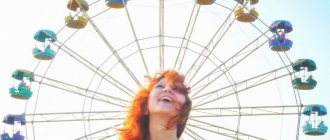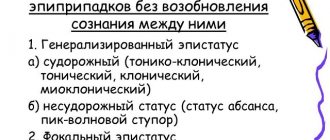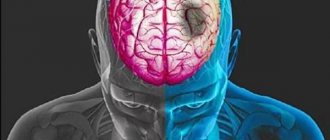Dizziness and vestibular disorders are related. The human vestibular apparatus is located in the inner part of the hearing organ. The human vestibular apparatus has receptors that are very sensitive and immediately detect any changes in body position. Vestibular vertigo creates a sensation of imaginary rotation of objects around the patient. Most often it is caused by certain damage to the vestibular apparatus; dizziness occurs as a result of damage to the central or peripheral parts of the vestibular analyzer. Other types of dizziness are associated with various diseases and are not related to damage to the vestibular system.
At the Yusupov Hospital they diagnose diseases that cause vestibular vertigo. In the hospital you can undergo examination, treatment and recovery in a rehabilitation clinic. The clinic carries out rehabilitation measures, uses therapeutic exercises, and various types of physiotherapeutic procedures. Instructors select exercises on simulators for patients suffering from dizziness. The vestibular apparatus, which is treated using various methods, is restored in 50-80% of patients after treatment and rehabilitation.
How to treat vestibular vertigo
Dizziness is a common complaint among patients about feeling unwell. Women and the elderly most often suffer from dizziness. Depending on the cause of dizziness, the doctor prescribes treatment. Treating dizziness is a difficult task for a doctor. He refers the patient for examination to determine whether dizziness is caused by diseases. The patient is prescribed symptomatic treatment, which helps to remove symptoms - nausea, vomiting, and stop attacks of dizziness. Vestibular suppressors are used to stop attacks. To prevent attacks from developing, your doctor may prescribe anticholinergic drugs. Such drugs are prescribed with caution to elderly people due to side effects - hallucinations, amnesia, they can cause urinary retention and psychosis in an elderly patient. Some types of antihistamines and benzodiazepines are also prescribed to enhance the inhibitory response of GABA to the patient’s vestibular system.
2. Reasons
It is assumed that the source of the vestibulopathic symptom complex is inflammation of the paired vestibular nerve. Various hypotheses have been put forward as to why this particular pair of cranial nerves is involved in the inflammatory process, while the neighboring ones remain intact; In addition, the etiopathogenesis of the inflammation itself is unknown. Considering the results of numerous clinical, medical-statistical, microbiological, pathomorphological and other studies carried out in this regard, the most likely causes today seem to be neuroinfection (especially herpetic), food intoxication, immune-allergic reaction (most likely, again, this is a reaction to some kind of respiratory or other infection), or a specific, possibly genetically determined, metabolic disorder. The most well-reasoned is the viral hypothesis, which is confirmed by a large number of accumulated observations, where the chronological connection between the acute respiratory viral infection and the subsequent development of acute peripheral vestibulopathy is clearly visible; it is legitimate to assume that this connection is also cause-and-effect.
Visit our Neurology page
Vestibular vertigo: symptoms and treatment in older people
Dizziness (vertigo) is manifested by the illusion of rapid rotation of objects around the patient. It may be accompanied by vomiting, nystagmus, nausea, and ringing in the ears. When vestibular vertigo develops in older people, the causes can be varied: lack of blood supply to the brain (cerebral ischemia), multiple sclerosis, head injuries, some types of brain tumors, tumors of the auditory nerve, hormonal imbalance, atherosclerosis, and other disorders. Treatment of vestibular vertigo (vertigo) in older people begins with finding the cause of the dizziness and treating the underlying disease. Vestibular gymnastics for dizziness in older people improves well-being, has a beneficial effect on the heart, musculoskeletal system, and nervous system. Treatment of vestibular vertigo is carried out with the help of drug therapy, physiotherapy, physical therapy, and reflexology.
4.Treatment
Therapy, due to the etiological uncertainty of the disease, is palliative in nature and is aimed at eliminating the dominant symptoms. Prescribe vestibular suppressants, drugs to suppress the urge to vomit, according to indications - tranquilizers, diuretics, etc. Special vestibular gymnastics has a good effect. It is important to note that without following the instructions for the rehabilitation period, there is a very high probability of the process becoming chronic with residual clinical signs of unilateral vestibular damage.
Diseases of the vestibular system and dizziness
There are a number of diseases that lead to disorders of the vestibular apparatus:
- Vertebrobasilar syndrome.
- Meniere's syndrome.
- Vestibular neuronitis.
- Thrombosis of the auditory artery.
- Chronic bilateral vestibulopathy.
Vestibular vertigo can be caused by damage to the vestibular nucleus of the brain stem, the vestibular centers of the brain and vestibular connections may be affected. If the vestibular analyzer is affected, the patient will experience certain symptoms:
- Noise in ears.
- Hearing loss.
- Constant dizziness.
When the central parts of the vestibular apparatus (cerebellum, brain stem) are affected, benign paroxysmal positional vertigo, vestibular neuronitis or Meniere's disease are most often diagnosed.
Vestibular disorders are among the most common in clinical practice. According to a recent study conducted in the United States, clinically obvious or hidden vestibular disorders are observed in 35% of Americans over 40 years of age [1]. The most characteristic manifestation of vestibular dysfunction is vestibular vertigo (VV) - the illusion of movement or rotation of surrounding objects or the patient himself in space. Vestibular, or systemic, dizziness, although inferior in frequency to non-systemic, is nevertheless quite common: its prevalence among adults reaches 5% [2].
Vestibular vertigo can be divided into acute and chronic. Acute VH is usually combined with more or less pronounced autonomic disorders in the form of nausea, vomiting, increased or decreased blood pressure, sweating, pallor, etc. In addition, acute dizziness is accompanied by instability and nystagmus. The duration of acute dizziness ranges from a few seconds to several days, but in practice it rarely exceeds 6–12 hours.
Chronic VH is manifested to a greater extent by instability, while the illusion of movement of surrounding objects mainly occurs briefly in response to turning the head or eyes.
Acute VH is caused by sudden damage to the vestibular analyzer at any level. Damage to the vestibular analyzer at the peripheral level (labyrinth of the inner ear or vestibular nerve) is most often caused by benign paroxysmal positional vertigo (BPPV), Meniere's disease and vestibular neuronitis. Damage to the vestibular analyzer at the central level (vestibular nuclei of the brain stem and numerous connections of the vestibular nuclei with other parts of the vestibular analyzer) in most cases is a consequence of migraine, as well as stroke or transient ischemic attack in the vertebrobasilar system.
Chronic VH can be a continuation of acute (in such cases it is caused by insufficient vestibular compensation) or arises primarily due to the gradual development of a pathological process (for example, due to neuroma of the vestibular-cochlear nerve) or bilateral symmetrical damage to the vestibular analyzers (as in bilateral vestibulopathy caused by the action of ototoxic substances ).
The principles of drug and non-drug treatment of acute and chronic dizziness differ significantly.
Pharmacotherapy of acute dizziness
Regardless of the cause of acute dizziness, representatives of two main groups remain the drugs of choice: vestibular suppressants and antiemetics.
Vestibular suppressants include antihistamines, anticholinergics, and benzodiazepines. The main vestibular suppressants are listed in table. 1.
Antihistamines
For vestibular vertigo, only those H1 blockers that penetrate the blood-brain barrier are effective. These drugs include dimenhydrinate (Dramina 50–100 mg 2–3 times a day), promethazine (Pipolfen 25 mg 2–3 times a day orally or intramuscularly), diphenhydramine (Diphenhydramine 25–50 mg orally 3–4 times a day). day or 10–50 mg IM) and meclozine (Bonin 25–100 mg/day in the form of chewable tablets). All of these drugs also have anticholinergic properties and cause corresponding side effects [3].
Anticholinergics
These drugs inhibit the activity of the central vestibular structures. Scopolamine or platyphylline are used. Side effects of these drugs are mainly due to the blockade of M-cholinergic receptors and include dry mouth, drowsiness and accommodation disorders. In addition, amnesia and hallucinations are possible. Scopolamine should be prescribed with great caution to the elderly due to the risk of developing psychosis or acute urinary retention.
It has now been proven that anticholinergic drugs do not reduce CH, but can only prevent its development, for example, in Meniere’s disease [4]. Because of their ability to slow down vestibular compensation or cause compensation to fail once it has already occurred, anticholinergics are increasingly used less frequently in peripheral vestibular disorders.
Benzodiazepines
The inhibitory transmitter of the vestibular system is gamma-aminobutyric acid, and benzodiazepines enhance the inhibitory effects of gamma-aminobutyric acid, which explains the effect of these drugs in VH. Even in small doses, benzodiazepines significantly reduce dizziness and associated nausea and vomiting. The risk of drug dependence, side effects (drowsiness, increased risk of falls, memory loss), as well as slower vestibular compensation limit their use in vestibular disorders. Lorazepam (Lorafen) is used, which in low doses (for example, 0.5 mg 2 times a day) rarely causes drug dependence and can be used sublingually (at a dose of 1 mg) for an acute attack of dizziness. Diazepam (Relanium) at a dose of 2 mg 2 times a day can also effectively reduce GV. Clonazepam (Antelepsin, Rivotril) has been less studied as a vestibular suppressant, but appears to be as effective as lorazepam and diazepam. It is usually prescribed at a dose of 0.5 mg 2 times a day. Long-acting benzodiazepines, such as phenazepam, are not effective for vestibular vertigo [5].
Vestibular suppressants slow down vestibular compensation, so their duration of use is usually limited to 2–3 days [6].
Antiemetics are often used in the same circumstances as vestibular suppressants. Moreover, most vestibular suppressants are also antiemetics. Among the most common antiemetics are phenothiazines, in particular prochlorperazine (Meterazine 5–10 mg 3–4 times daily) and promethazine (Pipolfen 12.5–25 mg 3 times daily orally or IM). Metoclopramide (Cerucal 10 mg IM) and domperidone (Motilium 10–20 mg 3–4 times a day orally) are peripheral D2 receptor blockers that normalize gastrointestinal motility and thereby also have an antiemetic effect [7]. Ondansetron (Zofran 4–8 mg orally) is a serotonin 5-HT3 receptor blocker that also reduces vomiting in vestibular disorders.
Antiemetics, like vestibular suppressants, can slow down vestibular compensation, so the duration of their use for vestibular disorders is limited to 2-3 days. There is evidence that ondansetron has no effect on central vestibular compensation [8]. Drugs with predominantly antiemetic activity are presented in table. 2.
Pharmacotherapy of chronic dizziness
Vestibular suppressants and antiemetics are ineffective in chronic VH. Moreover, since many cases of chronic dizziness are caused by insufficient vestibular compensation, drugs that depress the vestibular system may aggravate the patient's condition and delay recovery.
The basis for the treatment of chronic vestibular dysfunction is non-drug methods, primarily vestibular rehabilitation. The goal of vestibular rehabilitation is to accelerate vestibular compensation and create conditions for rapid adaptation to damage to the vestibular system. Vestibular gymnastics is based on exercises in which movements of the eyes, head and torso lead to sensory mismatch [5, 9]. These exercises stimulate central vestibular compensation. Clinical studies have shown that improvements in vestibular function and stability as a result of vestibular rehabilitation are observed in 50–80% of patients. Moreover, for a third, compensation is complete [10–12].
The possibilities of drug stimulation of vestibular compensation are currently limited. However, studies of various drugs supposedly stimulating vestibular compensation are ongoing. One such drug is betahistine dihydrochloride. By blocking H3 receptors in the central nervous system, it increases the release of neurotransmitters from the nerve endings of the presynaptic membrane, exerting an inhibitory effect on the vestibular nuclei of the brain stem. Experimental studies have shown that Betaserc accelerates vestibular compensation [13, 14]. Betahistine dihydrochloride is used in a dose of 24–48 mg daily for one or several months.
There is evidence of acceleration of vestibular compensation in diseases of the peripheral part of the vestibular analyzer under the influence of Ginkgo biloba extract [15, 16]. The drug is prescribed at a dose of 120 mg/day orally for one or several months.
Another drug believed to improve the speed and completeness of vestibular compensation is piracetam. This drug changes the speed of spread of excitation in the brain, improves metabolic processes in nerve cells, normalizes connections between the cerebral hemispheres and synaptic conduction in neocortical structures. It is believed that piracetam affects the vestibular and oculomotor nuclei of the brainstem, accelerating vestibular compensation [17]. Piracetam is recommended primarily for dizziness caused by damage to the central vestibular structures. Piracetam is prescribed orally at a dose of 2400–4800 mg/day; Duration of treatment – from one to several months.
Pharmacotherapy of the most common vestibular diseases
Benign paroxysmal positional vertigo
The basis of treatment for BPPV is not drugs, but special exercises and therapeutic maneuvers that have been actively developed over the past 20 years [18–21].
Drug treatment is used only in the most acute period, when it is necessary to reduce the severity of episodes of positional vertigo, and as a premedication during positional maneuvers. In these cases, vestibular suppressants and antiemetics are used. In addition, there are limited data indicating the ability of betahistine dihydrochloride to increase the effectiveness of therapeutic positional maneuvers for BPPV [22] and reduce the duration of the period of instability after a successful positional maneuver [23].
Meniere's disease
To date, Meniere's disease remains an incurable disease. The goal of treatment is to reduce the frequency and severity of dizziness attacks [24–26]. For this purpose, diuretics are prescribed (acetazolamide or hydrochlorothiazide in combination with triamterene). However, to date, no convincing data have been obtained indicating the effectiveness of diuretics in Meniere’s disease [27].
Another drug that can reduce the frequency and severity of dizziness attacks in Meniere's disease is betahistine dihydrochloride. It is usually prescribed at a dose of 48 mg per day and taken long-term – for several months and sometimes years [14]. Recently, data have appeared on the effectiveness and safety of the use of high doses of betahistine in Meniere's disease [28].
Vestibular neuronitis
Drug treatment of vestibular neuronitis mainly consists of the use of symptomatic drugs: vestibular suppressants and antiemetics. Recently, evidence has emerged indicating the effectiveness of corticosteroids in vestibular neuronitis, but these data have not been confirmed by a meta-analysis [29].
Migraine-associated dizziness
The treatment of migraine-associated dizziness generally uses the same approaches as the treatment of regular migraine. However, due to the current lack of consensus regarding the diagnostic criteria for migraine-associated dizziness and the very fact of the existence of this pathology, there have been almost no controlled studies of the effectiveness of certain therapeutic approaches. To relieve an attack of migraine-associated dizziness, as with any other acute VH, vestibular suppressants and antiemetics are used. Preventive therapy is indicated for frequent (2 or more per month) and severe vestibular migraine attacks [30, 31].
The drugs of choice are beta-blockers (propranolol or metoprolol), tricyclic antidepressants (nortriptyline or amitriptyline) and calcium antagonists (verapamil). In addition, valproate (600–1200 mg/day) and lamotrigine (50–100 mg/day) are used. The starting daily dose of verapamil is 120–240 mg/day; the maximum daily dose should not exceed 480 mg. The starting dose of nortriptyline is 10 mg/day; if ineffective, the dose is increased to 10–25 mg/day, while the maximum daily dose should not exceed 100 mg. The starting dose of propranolol is 40 mg/day; if this dose is ineffective and the drug is well tolerated, the daily dose is gradually (weekly) increased by 20 mg, but so that it does not exceed 240–320 mg. There is also evidence of the effectiveness of topiramate as a means of preventing migraine-associated dizziness [32].
Thus, the possibilities of drug therapy for vestibular vertigo are quite large. There are a sufficient number of drugs for both symptomatic treatment of dizziness and pathogenetic therapy. Correctly selected and timely prescribed medications can significantly improve the quality of life of most patients with various diseases of the vestibular system.
Benign vestibular vertigo
Benign vestibular vertigo is most often considered a pathology of the inner ear; dizziness often occurs when turning the head to the side. The disease may manifest as sudden severe dizziness, nausea and vomiting. Paroxysmal benign positional vertigo develops as a result of the deposition of calcium salts in the ampulla of the semicircular canal. Peripheral vestibular vertigo occurs when the peripheral part of the vestibular apparatus is damaged. Systemic vestibular vertigo is manifested by symptoms of swaying one's own body, rotating objects, bending or falling, accompanied by impaired hearing, balance, nausea and vomiting. Caused by damage to the central or peripheral part of the vestibular system.
Non-vestibular vertigo
Disturbances in the functioning of internal organs that are not directly related to the vestibular analyzer can also be accompanied by dizziness of various types. Moreover, the features of their manifestation help determine the cause of the disorder.
Thus, a feeling of rapid loss of consciousness, lasting from a few seconds to a couple of minutes and passing after a person sits down or lies down, most often occurs when:
- pathologies of the cardiovascular system, including arrhythmias, hypertension, cardiomyopathy, heart failure, myocardial infarction;
- depression;
- anemia (decreased number of red blood cells and hemoglobin in the blood);
- diabetes mellitus;
- malnutrition.
Also, a pre-fainting state can develop with arterial orthostatic hypotension (a sudden decrease in blood pressure when suddenly getting up from a bed or sofa). This is due to a decrease in the tone of blood vessels, but in general does not pose a danger.
Chronic dizziness, imbalance, changes in walking with the appearance of a drunken gait, uncertainty when standing are more typical for older people and are a consequence of the development of one or several of the following diseases:
- heart failure;
- myocardial infarction;
- arthritis;
- stroke;
- diabetes;
- hypoglycemia;
- depressive states.
Sometimes problems with maintaining balance and dizziness occur while taking antihypertensive, antituberculosis, antiparkinsonian drugs, aminoglycoside antibiotics, antidepressants, or alcohol abuse, smoking.
Persistent postural-perceptual vertigo (PPPG), which was previously called psychogenic, is most often caused by a past history of a disease that affects the functioning of the vestibular analyzer, for example, inflammation of the vestibular nerve, Meniere's disease, concussion, etc. Thus, it is typical for a person who has already recovered and is largely due to anxiety about his condition. PPPG is typically characterized by a feeling of fog in the head and swaying when walking, but no impairment of coordination is objectively detected. Although symptoms may persist for several months, various environmental factors, from moving objects to crowds, can trigger or intensify an attack.
Exercises for vestibular vertigo
Dizziness often occurs when turning the head or body - this forces patients to try to avoid such movements. Gymnastics for patients with vestibular system disorders includes various types of exercises, including exercises with head and body turns. Exercises can be performed while sitting on a bed, with or without a pillow, sitting on a chair, or standing. The exercises are based on the principle of sensory mismatch between the movements of the eyes, torso and head. Special simulators that work on the principle of biofeedback will help increase the effectiveness of gymnastics. During the training period, you should avoid taking sedatives and alcohol.
Diagnostics
Since dizziness can be a symptom of many different diseases, you should consult a doctor if it occurs. Initially, you should consult a therapist who will prescribe OAC, OAM, a blood sugar test and will be able to exclude or confirm the simplest causes of dizziness. If they do not show changes, the doctor, based on the characteristics of the manifestation of dizziness, will refer the patient to a neurologist. You may also need to additionally consult a cardiologist and an ENT specialist.
At the initial appointment, the doctor initially collects anamnesis. He is interested in when and under what circumstances attacks occur, their duration, the nature of the sensations and the presence of accompanying symptoms. After this, an inspection is carried out. First of all, the presence and nature of nystagmus (involuntary oscillatory movements of the eyeballs), gait disturbances with open and closed eyes are assessed, and the Romberg test is performed to determine the degree of stability. To perform it, you need to stand up, put your feet together, close your eyes and stretch your arms in front of you. Normally, a person maintains balance, does not stagger or fall.
Patients are also asked to undergo several tests:
- Dix-Hallpike test - the patient sits on the couch, and the doctor turns his head 45° to the side, quickly positions him so that his head hangs over the edge of the couch, and carefully monitors the eyes and the pattern of changes in nystagmus. The patient himself must report his feelings. The test is repeated with the head turned in the opposite direction.
- Halmagi-Kerthoys test - the patient fixes his gaze on a certain point on the doctor’s face. The specialist, holding his head with both hands, sharply turns it at a small angle in any direction.
- Marching test. The patient closes his eyes and stretches his arms in front of him. In this position, he needs to take about 50 steps in place with his knees raised high. After this, it is assessed how far it has moved from its original position.
- Orthostatic test - the patient lies on the couch, and the doctor measures blood pressure. After this, he needs to stand up sharply. The pressure is re-measured immediately and then after 3 minutes.
As a rule, the data obtained as a result of such an examination is sufficient to establish the cause of dizziness. But if it indicates the possibility of developing pathologies of the spine or cardiovascular system, the following are additionally prescribed:
- CT;
- MRI;
- Ultrasound of the vessels of the neck and head;
- audiometry;
- ECG;
- Ultrasound of the heart;
- stabilography.
Tablets for vestibular vertigo
Drugs for vestibular vertigo are Betaserc, Betagistin, Tagista, Vestibo, as well as drugs that support the endocrine system, the heart, and reduce blood pressure. Betaserc improves blood circulation in the brain and promotes the functioning of the vestibular apparatus. Betahistine is often used in complex treatment; it helps with nausea and vomiting. Tagista improves blood circulation in the brain and reduces lymph pressure in the labyrinth of the inner ear. A stable effect is achieved after a month of treatment. Vestibo improves blood circulation in the inner ear and brain; the drug is used in complex therapy.
Causes of development of impaired coordination of movements
It is important to understand that coordination disorder can manifest itself not only in neurological pathologies and as a side symptom accompanies various diseases. There are many reasons for it:
- cerebrovascular insufficiency, focal cerebral infarctions or strokes;
- brain or spinal cord injuries;
- brain tumors;
- demyelinating diseases (eg, multiple sclerosis);
- congenital malformations of the brain or its vascular system;
- hydrocephalus (both congenital and acquired);
- neuroinfections;
- endocrine disorders;
- various poisonings;
- alcoholism;
- deficiency of vitamin B12 in the body.
Treatment in Moscow
The best treatment for vestibular disorders is considered to be exercises for dizziness or vestibular rehabilitation. Vestibular rehabilitation is carried out in many special centers, including the rehabilitation center of the Yusupov Hospital. Therapeutic gymnastics is carried out by an instructor, classes are developed individually for each patient. A preliminary examination by a neurologist will help determine the cause of dizziness, and the doctor will prescribe effective drug treatment. A neurologist will tell you what examination to undergo and how to cure vestibular vertigo during your consultation.
Treatment of ataxia
In treatment, neurologists are greatly assisted by establishing the cause and mechanism of development of the disease. In the treatment of motor coordination disorder, a complex of drug support, physiotherapy and a set of exercises is effective.
Often the main groups of drugs are nootropics, tonics and vitamins. The course of treatment and its volume is determined by the doctor after establishing the cause of the development of ataxia exclusively on an individual basis.
Surgery can also help, for example, removing a tumor or hematoma of the brain, ensuring the outflow of cerebrospinal fluid in case of hydrocephalus, and so on.
Physical rehabilitation increases the chances of maximum recovery and return to normal. It should include sets of exercises with the following components:
- static and dynamic balance;
- prevention of contracture formation;
- general coordination of movements
Prevention of ataxia
The main measures to prevent the disease are timely prevention and treatment of diseases and conditions that cause it.










